Creative Grain-Centric Dinner Ideas for Busy Lives
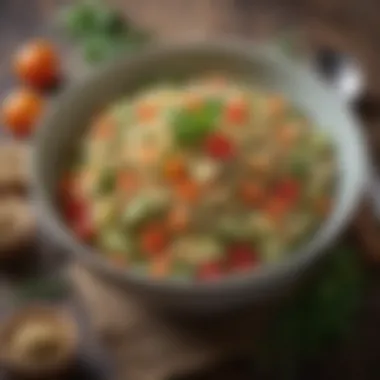
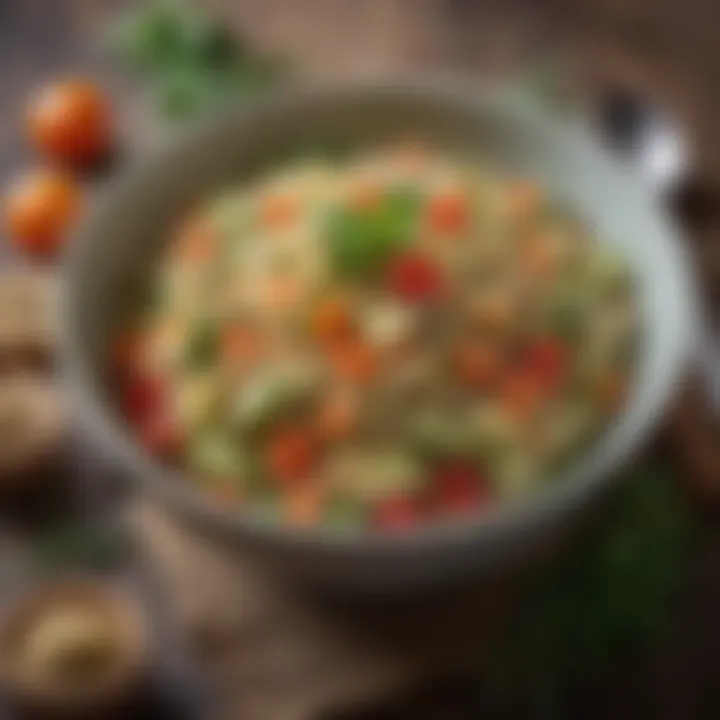
Intro
The world of grains is as extensive as it is exciting. These humble seeds, often overlooked, can transform any dinner table into an inviting feast. Whether you're a busy professional or a home cook, grains provide a canvas for creativity and health. They’re not just filler; they're bursting with nutrition and flavor. This guide seeks to reveal the potential of grains, showing how they can be integrated seamlessly into your nightly meals, while also hitting the sweet spot of nutrition and taste.
Now, let's delve into the first recipe that can kickstart your grain journey—one that balances ease and elegance.
Understanding Grains: An Overview
Grains often sit at the heart of many meals, serving as a versatile and nutrient-dense base. Their importance cannot be overstated, especially when aiming to create satisfying and balanced dinners. With several varieties available, understanding grains can greatly enhance meal planning and nutritional intake. They offer up a canvas upon which myriad flavors and textures can be painted, making them both a staple and a gourmet option in the culinary world.
In the context of this article, grasping the fundamental concepts of grains—what they are, their types, and their nutritional benefits—sets the stage for incorporating them into dinner recipes. Exploring grains helps home cooks not only to appreciate their diversity but also to think outside the box when preparing meals, moving beyond the usual rice or pasta.
Healthy eating trends increasingly highlight the need to make grains a regular part of our diets. This section aims to arm readers with essential knowledge, helping to demystify grains and establish them as key players in sumptuous dinners.
What Are Grains?
Grains, in the simplest terms, are the seeds of grass. They are a fundamental source of calories and nutrients for countless populations worldwide. Typically, grains can be classified into two broad categories: whole grains and refined grains. Whole grains include all parts of the grain seed—the bran, germ, and endosperm—resulting in a rich source of fiber and nutrients. In contrast, refined grains have been milled to remove the bran and germ, enhancing shelf life but stripping away several beneficial components.
Grains like rice, wheat, oats, and barley and grain-like seeds such as quinoa and amaranth play a significant role in cultures and cuisines globally. Understanding the distinct characteristics of grains is essential for making informed choices in meal preparation.
Types of Grains: A Comprehensive Guide
Whole Grains
Whole grains are celebrated for their health benefits, primarily due to their intact structure which retains vital nutrients. They are high in dietary fiber, which is known to aid digestion, help maintain a healthy weight, and lower the risk of chronic diseases. Common examples of whole grains include brown rice, quinoa, and whole wheat. The key characteristic of whole grains is their ability to offer a more satiating meal while delivering essential vitamins and minerals. Using whole grains in dinner recipes not only enriches the meal but also elevates the overall nutritional profile, making them a popular choice in the health-conscious cooking sphere.
Despite their numerous advantages, whole grains may require more cooking time than their refined counterparts, and some people may find their taste and texture less appealing initially.
Refined Grains
Refined grains, on the other hand, have undergone processing that removes the bran and germ. Most commonly represented by white rice and white bread, refined grains are appealing for their smooth texture and quick cooking properties. However, this processing strips away many nutrients, such as fiber, iron, and B vitamins. Though they may be more palatable and easier to prepare, refined grains do not carry the same health benefits as whole grains.
It's essential to be mindful of their consumption; incorporating refined grains into meals isn’t a bad thing in moderation, particularly when balanced with other nutrient-rich foods.
Gluten-Free Options
Gluten-free grains have surged in popularity due to rising awareness around celiac disease and gluten sensitivities. Grains like rice, corn, and oats (when certified gluten-free), as well as ancient grains like millet and buckwheat, provide excellent alternative sources of nutrition. A key feature of gluten-free grains is their ability to cater to diverse dietary needs without sacrificing flavor or nutritional quality.
While they are a beneficial choice for those who need to avoid gluten, some may struggle to find gluten-free grains that are as versatile or accessible as traditional options. Understanding which gluten-free grains can enhance a meal's texture and flavor is vital to culinary innovation.
Nutritional Benefits of Eating Grains
Eating grains brings several nutritional advantages. They can serve as a powerhouse of energy, providing the carbohydrates needed for a busy lifestyle. Notably, different types of grains offer unique nutrients that can contribute to a balanced diet.
Fiber Content
A standout feature of many grains is their high fiber content, playing a pivotal role in promoting digestive health. Foods rich in fiber take longer to chew and digest, leading to longer-lasting satiety and better blood sugar control. Incorporating fiber-rich grains into dinners can assist in weight management while reducing the risk of chronic conditions such as heart disease.
However, too much fiber too quickly may cause digestive issues for some, so gradual integration is key.
Vitamins and Minerals
Grains are loaded with essential vitamins and minerals, particularly B vitamins such as niacin, thiamin, and folate, as well as important minerals like iron and magnesium. These nutrients contribute to energy production and support various bodily functions. By focusing on whole grains, one ensures that they’re not just filling up but also gaining beneficial nutrients that support overall well-being.
Nevertheless, it’s crucial to pair grains with other food groups to ensure a well-rounded nutrient profile in each meal.
Plant-Based Protein
For those adopting plant-based diets, grains, particularly when combined with legumes, can provide a significant protein source. Grains like quinoa stand out for containing all nine essential amino acids, making them a complete protein. Integrating grains into dinner can ensure adequate protein intake while also catering to one's lifestyle preferences.


Though plant-based protein is a smart choice, solely relying on grains may leave one short on certain key nutrients, so variety in sources is important.
Incorporating Grains into Dinner
Integrating grains into dinner options serves a dual purpose: it enhances the nutritional value of meals while providing a diverse base for creativity in cooking. As the shift toward healthier lifestyles continues, utilizing grains can be a key element in achieving a balanced plate. They contribute not only to satiety due to their fiber content, but also add an array of flavors and textures that keep meals interesting. Incorporating grains means taking a commitment to elevate standard dinners into something more fulfilling and wholesome.
Planning Your Meal Around Grains
Choosing Complementary Ingredients
Choosing complementary ingredients is essential for a balanced dish when planning meals centered around grains. The idea here is to make the grains the star of the show without overpowering them. For instance, quinoa pairs elegantly with roasted veggies and a hint of zing from lemon juice. This combination brings out the nutty flavor of the quinoa while ensuring the veggies retain their crunch.
The versatility of grains allows for various proteins and greens to take center stage, making it a popular choice for dinner. You can combine something like farro with grilled chicken and arugula. The nutty farro and the peppery arugula create a nice contrast, making the dish not just palatable but also visually appealing. However, it’s important to be mindful of not overcrowding flavors; if too many strong tastes collide, it can muddy the overall vibe.
Balancing Flavors and Textures
Balancing flavors and textures not only boosts the enjoyment of the meal but is also a fundamental culinary principle. When grains are complemented with ingredients that contrast in texture — such as soft avocados against the firmness of brown rice — it creates a pleasing mouthfeel. It's this interplay of flavors and textures that can elevate a meal from mundane to memorable.
In addition to the texture dimension, the consideration of sweet and savory combinations can take a dish much further. Imagine mixing wild rice with roasted butternut squash and a sprinkle of feta. The winter squash contributes a hint of sweetness, while the feta imparts a tangy note. However, be cautious; overwhelming the grains with too many flavors might lead to one dominating the other, defeating the purpose of creating a harmonious dish.
Quick Cooking Methods for Grains
Boiling and Steaming
Boiling and steaming are among the most straightforward methods for preparing grains, making them incredibly accessible for busy cooks. Boiling allows for a more robust cooking process that can yield fluffy grains, while steaming preserves more nutrients. For instance, if you boil brown rice, it can yield a heartier texture that holds up beautifully in salads. This cooking method can appeal to anyone looking for efficiency without sacrificing quality.
Using these methods is friendly on time too; with a pot of boiling water, grains can often be prepared in about 20 minutes. There's a simplicity that resonates with those juggling hectic schedules, making it an effective choice for weeknight dinners. However, layering the flavors adequately can sometimes be a challenge, as boiling might lead to a less defined taste without the addition of spices or broth.
Methods for Quick Cooking
Various methods for quick cooking grains are essential tools for today’s kitchen. Microwave cooking is increasingly popular for its speed, offering an alternative to traditional methods. For instance, using microwave-safe containers allows you to prepare grains in a fraction of the time with minimal cleanup. This practicality is a boon for those who value both time and ease.
While this method is efficient, it does often require meticulous measuring and timing to avoid unevenly cooked grains. A start-to-finish cooking time of under ten minutes can be a game-changer, but ensuring that microwave cooking achieves the quintessential texture of grains might take practice.
Use of Pressure Cookers and Rice Cookers
The use of pressure cookers and rice cookers further simplifies grain cooking. These appliances are lifesavers, especially when preparing meals for multiple people. With a pressure cooker, a pot of lentils can be whipped up in about 15 minutes, which is far less time than it would take on the stovetop. The efficiency of these tools makes it easy for anyone to incorporate proteins and veggies into a grain dish, creating a well-rounded meal in no time.
One caveat, however, is the learning curve. Getting to understand the right settings for various grains might take a bit of trial and error. Still, the benefits typically outweigh the initial hassles, providing a reliable way to ensure perfectly cooked grains every time.
"Incorporating grains into meals doesn't just boost nutrition; it opens the door to endless culinary creativity."
Ultimately, incorporating grains into dinner isn't merely about cooking; it's about transforming the mealtime experience. By thoughtfully planning around grains, balancing their flavors and textures, and applying quick cooking methods, one can enjoy a wide array of delicious and healthy dishes.
Creative Grain-Based Dinner Ideas
In the culinary landscape, grains often play second fiddle to proteins or vegetables, but they have a multitude of possibilities that can elevate any dinner. Not only are grains versatile, but they also serve as a hearty base that brings together a myriad of flavors and textures. Focusing on creative grain-based dinner ideas allows cooks to experiment beyond the usual fare while embracing nutritional benefits. Grain-centric meals can be easy to customize and cater to various dietary restrictions, making them a wise choice for different diners. From wholesome grain bowls to delightful one-pot dishes, the world of grain dinners is just waiting to be explored.
Wholesome Grain Bowls
Base Ingredients and Combinations
When it comes to creating a grain bowl, the base you choose is essential to the overall experience. Diverse grains like quinoa, farro, and barley offer unique textures and flavors that set the stage for creativity. Each grain brings its own personality—quinoa's fluffy and nutty character contrasts beautifully with farro's chewy bite.
A key benefit of using grains as a base is their ability to fill you up without leaving you in a food coma. They naturally complement a wide array of toppings. This flexibility lends itself well to experimentation, making it easier to cater to seasonal produce or what you have lingering in your pantry. While diverse combinations are a strong point, be cautious to avoid overwhelming the dish; simplicity often reigns supreme in flavor and balance. Here’s a quick idea: try a warm quinoa base topped with roasted vegetables, nuts, and a drizzle of tahini sauce to kick it up a notch.
Dressing and Sauces to Enhance Flavor
The right dressing can make or break a wholesome grain bowl. Rather than relying on store-bought options, consider whipping up unique sauces or dressings. A zesty lemon-tahini dressing or a smoky chipotle yogurt sauce can add distinct layers of flavor to your grains.
Key characteristics of these dressings are their ability to meld with the grains and other ingredients, enhancing the overall experience without masking the individual flavors. Homemade dressings can be adjusted to cater to your taste or dietary requirement, another essential benefit for the modern cook.
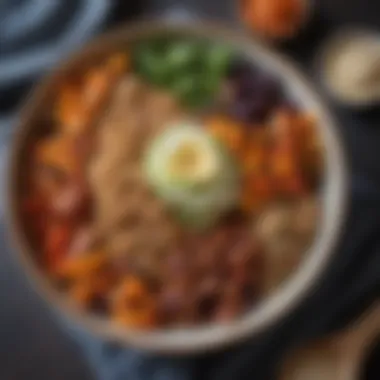
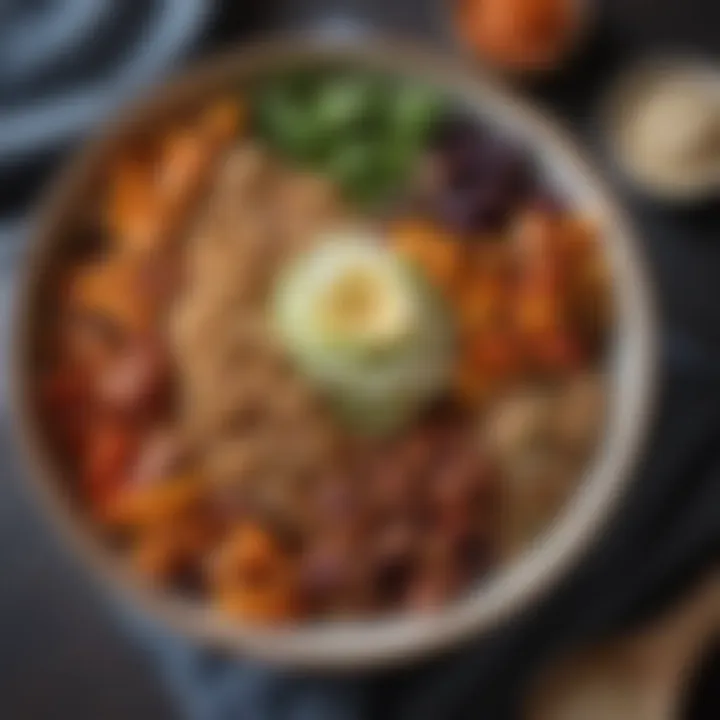
A unique feature of these sauces is their versatility; the same dressing can complement different grain bases or toppings effectively. However, it’s crucial to remember that a sauce too heavy can overshadow the delicate flavors of your carefully chosen grains.
Grains in Salads and Side Dishes
Salad Compositions
Incorporating grains into salads adds delightful texture and makes them more filling. They serve a dual purpose. Not only do they provide sustenance, but they also offer a canvas for vivid ingredients. For instance, a barley salad mixed with cherry tomatoes, cucumber, and a herb vinaigrette can offer a refreshing experience.
The key characteristic of grain salads is their adaptability; you can adjust the ingredients based on what’s fresh or seasonal. This not only elevates the flavor but also optimizes nutritional content.
However, be cautionary—mixing too many bold flavored grains and dressings can create a culinary clash. Choose ingredients that harmonize and respect the grain at the center of the dish.
Seasonal Ingredients for Freshness
Using seasonal ingredients in grain salads offers a clear boost in flavor and nutrition. Whether you’re using tender spring peas or juicy summer peaches, seasonal produce adds layers of freshness. Each season unfolds a new palette of flavors, pushing the creativity of your grain dishes.
Picking ingredients that are at their peak ensures not only taste but also sustenance without heavy processing. This benefits your health as well as supports local farmers. Emphasizing seasonal ingredients is also a beneficial approach in the context of sustainability, reducing the carbon footprint associated with your meals. Yet, be aware of the limitations that seasons impose; certain ingredients may be scarce or unavailable.
One-Pot Grain Dishes
Casseroles and Bake Recipes
One-pot dishes are the lifeboat for busy weeknights. Casseroles often use grains as a filling base, which is not only practical but allows the dish to absorb flavors from the added proteins and vegetables. Think of a cozy quinoa casserole filled with broccoli, cheese, and spices— perfect for all the taste-buds!
The key characteristic here is convenience; while you can feed a crowd, the clean-up is minimal. This makes them a star in the arena of practical cooking.
However, balancing the moisture and delicacy of grains alongside richly textured ingredients is key. Too much liquid, and your dish risks becoming mushy. Less is often, more when it comes to enhancing flavors while ensuring an enjoyable texture.
Stir-fries and Mixed Dishes
Stir-fry dishes featuring grains can be incredibly gratifying and flavor-rich. By tossing cooked grains with vegetables and proteins of choice cooked in a soy or teriyaki sauce, you create a balanced, quick meal. The key characteristics of stir-fries are their speed and adaptability, which allow them to fit neatly into cramped schedules.
The unique feature here, apart from their quick preparation, is the vivid colors and textures they present. The aromatic spices and sauces might encourage culinary adventurers to try new flavor profiles. That said, it is important to time the cooking of ingredients wisely; keeping everything from becoming overcooked and mushy is essential in creating a truly delightful stir-fry.
Practical Tips for Busy Cooks
Busy cooks can sometimes feel like they're constantly in a race against the clock, especially when it comes to preparing dinner. However, focusing on grains can provide an efficient and healthy centerpiece for meals. Here, we’ll dive into some practical strategies that make grain-centric cooking accessible, even on the most hectic days. These tips not only save time but also maximize nutrition, allowing you to enjoy delightful dinners without breaking a sweat.
Batch Cooking Grains
Preparation for the Week Ahead
Batch cooking grains is a cornerstone technique for those looking to streamline their dinner process. By dedicating a little time to cook large quantities of grains, you can set yourself up for success throughout the week. Imagine this: on a Sunday afternoon, you prepare quinoa, brown rice, and farro in one go. Not only do you have multiple options ready, but you also have saved yourself from the daily grind of cooking from scratch.
The key characteristic here is efficiency. Preparing ahead means you can assemble meals in no time. Leftover grains can easily be incorporated into salads, stir-fries or even warm bowls. This practice transforms what could feel like a chore into a routine that positions you for a healthier week.
That being said, it’s helpful to keep in mind that overcooking during batch prep could potentially lead to a mushy texture, especially if grains are stored incorrectly. However, with the right balance, this method is a winning choice for anyone needing a quick dinner solution.
Storage Solutions and Tips
Once you’ve cooked batches of grains, proper storage becomes essential. Understanding how to store grains can enhance their longevity and retain quality. For instance, keeping grains in airtight containers in your refrigerator prevents unnecessary spoilage. This addresses the challenges of texture and taste deterioration when grains are left exposed in traditional containers.
The main advantage of these storage practices is that they protect your investment in meal prep. If you can easily pull out perfectly cooked grains that maintain their flavor, dinner preparation becomes a shorter ordeal.
However, do remember that grains should usually be eaten within a week for the best flavor and freshness. This little tip can make a big difference in how much you enjoy each meal throughout the week.
Making Use of Leftover Grains
Transforming Leftovers into New Meals
Turning leftover grains into entirely new meals can be a game changer for busy cooks. This technique not only minimizes waste but also expands your meal possibilities beyond repetitive servings. Picture transforming leftover barley from a salad into a hearty soup by simply adding broth and vegetables.

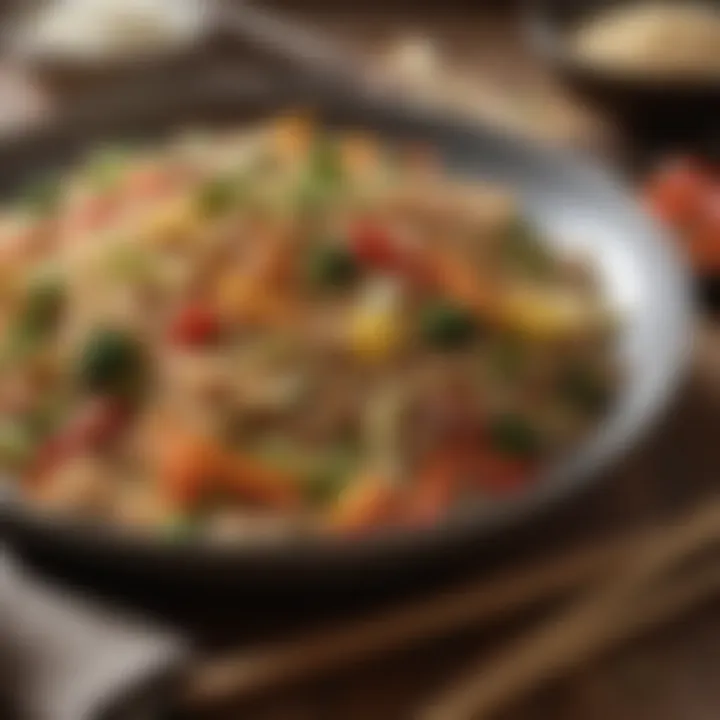
One key aspect is flexibility. Grains can adapt to various flavor profiles, making it easy to pair them with whatever ingredients you might have on hand. This approach to leftovers is not only resourceful but significantly cuts down on the time spent in the kitchen.
The uniqueness here is that you can create gourmet meals out of yesterday's remnants. However, it’s important to pair leftovers with fresh ingredients to maintain a delightful texture and flavor contrast. This balance ensures your meal feels fresh enough while still capitalizing on what you already have cooked.
Creative Reuse in Recipes
The notion of creatively reusing grains in recipes is effective in ensuring no grain goes to waste and adds an exciting element to your cooking. For example, leftover couscous can transform into a delightful breakfast bowl when combined with yogurt, fruit, and nuts.
The core characteristic here is imagination. You can take what’s in your pantry and use grains as the foundation for diverse dishes, from breakfast to desserts. This aspect makes grain-based recipes appealing for busy lifestyles where variety often gets lost.
However, it’s essential to remain aware that not all grains will work seamlessly across recipes. For instance, using leftover rice in a sweet dish might not yield the desired result. Therefore, getting familiar with grain properties will help make the best choices in utilizing every last bit from your meal prep.
"Being resourceful not only saves time but transforms cooking into a delightful exploration of flavors."
Conclusion: The practical tips for busy cooks highlight the importance of planning and creativity when it comes to culinary endeavors centered around grains. Embracing these approaches can change the way you structure your meals, ensuring both health and efficiency reign supreme.
Exploring Global Grain Dishes
Delving into the realm of global grain dishes propels a culinary enthusiast into a rich tapestry of flavors, textures, and traditions. Exploring these dishes is not just about recipes; it’s about understanding cultural identities and the unique ways people have adapted grains to their local tastes and resources. Grains are staple foods for many communities worldwide. They serve as a foundational ingredient that varies significantly in preparation, seasoning, and accompaniments.
Cultural Influences on Grain Usage
The manner in which grains are utilized in different cultures reveals much about their agricultural practices, climates, and histories. Grains have shaped societies, supported communities, and fostered local economies.
Regional Grain Specialties
Each region often boasts its own grain specialties, with localized varieties that reflect the land’s characteristics. For instance, quinoa is sacred in Andean cultures, seen not just as a food but as a neighbor of the gods. Its inclusion in modern meals is gaining traction for its high protein content and earthy flavor.
The use of farro in Italy showcases an ancient grain's versatility, as it's found in everything from soups to salads. Farro’s nutty flavor and robust texture make it a preferred choice for heartier dishes that fill the belly and comfort the soul.
Regionally-specialized grains can serve as beneficial choices due to their unique flavors and textures that enhance various grain-based meals, allowing cooks to showcase the essence of their culture. However, the challenge often lies in accessibility; not every specialty grain is easily found outside of its native region.
Traditional Dishes from Around the World
Looking at traditional grain dishes crafted by different cultures highlights their culinary heritage. For instance, biryani in South Asia parallels rice and aromatic spices, creating a fragrant harmony that tells stories of gatherings and celebrations. The dish stands out due to its layers of flavors, embodying both simplicity and elegance in its preparation.
Another notable example is tamales from Mexico, a dish comprising masa—corn dough—wrapped around various fillings. This dish showcases the integration of social traditions and cooking techniques passed down through generations.
Traditional grain dishes not only provide sustenance but create a sense of community, making them invaluable. The downside can be that these intricate dishes, while delightful, often require skilled preparation and time, which can thwart busy cooks trying to incorporate them into nightly meals.
Modern Twists on Classic Grain Dishes
Fusion Recipes
In today's culinary scene, fusion recipes have gained momentum, as they allow for creativity and innovation in grain dishes. By mixing elements from different cuisines, chefs are crafting dishes like sushi burritos, which combine the portability of the burrito with the essence of sushi. This modern take offers ease of eating without sacrificing flavor.
This genre of cooking not only proves a popular choice among food enthusiasts but also helps in reaching broader audiences. With a myriad of flavors and textures, there's the potential to turn everyday ingredients into something extraordinary. Nonetheless, there might be criticism for straying too far from traditional methods and flavors, sometimes leading to a lack of authenticity.
Healthier Alternatives to Traditional Dishes
With a growing focus on health, there's a trend towards healthier alternatives to beloved traditional dishes. For example, cauliflower rice has emerged as a trendy substitute for regular rice in stir-fries or grain bowls, offering a lighter option without sacrificing the comforting feel of the original dish.
Emphasizing whole grains, dishes can be reimagined to provide nutritional benefits while still catering to cravings. This approach can appeal to those seeking healthier selections, merging pleasure and nutrition seamlessly. However, the challenge lies in ensuring that these alternatives maintain the depth of flavor and satisfaction associated with traditional recipes, which can sometimes lead to disappointing variations.
Exploring global grain dishes not only brings diversity to the plate but also fosters appreciation for culinary traditions around the world. Embracing these dishes means celebrating culture, history, and the endless ingenuity behind grain preparation.
Ending
In this bustling world, where life often feels like a race against time, the significance of grains in our daily meals cannot be overstated. Grains serve not just as an energy source; they align with our quest for healthier, more balanced dinners. They act as the backbone of countless dishes – from comforting bowls of rice to hearty quinoa salads. In addition to their versatility, grains are packed with vital nutrients that cater to both taste and wellness.
Embracing grains in dinner meals can reframe our culinary experience. By integrating whole grains into the diet, we not only boost our nutritional intake but also invite a palette of flavors and textures onto our plates. For instance, swapping out white rice for farro or barley opens up a myriad of possibilities in terms of taste and health benefits. Following that trail, savoring the chewiness of spelt or the nuttiness of freekeh can elevate ordinary dishes into something special.
Moreover, most grains are quite easy to cook and can fit seamlessly into a busy lifestyle. The methods of incorporating these grains don't demand elaborate preparations. Those quick cooking methods or one-pot dishes can help anyone, from the novice cook to the seasoned chef, to whip up a delicious meal in no time. As we streamline our meal prep, we save energy and time without compromising on what goes into our bodies.
"A meal without grains is like a day without sunshine."
Thus, the act of embracing grains goes beyond mere dietary choices; it's about acknowledging their nutritional benefits and the cultural traditions they carry. We link ourselves to various cuisines, exploring meals that have stood the test of time while also allowing room for our own innovations. In the end, the incorporation of grains into our dinners not only nourishes our bodies but also fosters a holistic connection to food and culture, paving the way for a healthier future.







